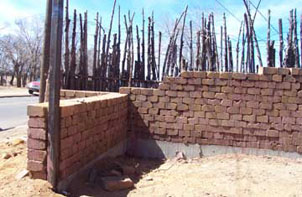COMPRESSED EARTHEN BLOCKS:
WHAT THEY ARE AND ARE NOT

A Compressed Earthen Block ("CEB") is not an Adobe.
An adobe by definition is a block made from a mud mixture consisting of silts and clays (maximum 20% - 25%) and aggregate (the balance) usually with straw added, that is cast in a form and allowed to dry.
A CEB may have a much higher percentage of clay-to-aggregate, in fact it should have, and is produced by hydraulically pressing the damp earth. The block does not require a "set" or "cure" time and may be placed directly in the wall.
An adobe has comparatively low compressive strength and a may have a comparatively high modulus of rupture.
A CEB may have a comparatively low modulus of rupture, but almost always has two to three times the compressive strength of an adobe. In mechanical load tests, the CEB will outperform an adobe.
("Drop-testing" adobes or pressed block is not an indicator of either modulus of rupture or compressive strength. It may inaccurately indicate some of the cohesive properties of the soils in the block.)
Soil particles in an adobe are bonded together mechanically and to a lesser degree, chemically. An exposed CEB, because it usually has a higher aggregate content, tends to erode more slowly than an exposed adobe.
Soil particles in a CEB are bonded together mechanically.
Both adobes and Compressed Earthen Blocks can and should be plastered without the use of moisture barriers or lath if a permeable (mud or lime-based) plaster is used. This is because both types of block are themselves permeable and will dispel water nearly as quickly as they absorb it, provided the water is not trapped behind an impermeable sheathing. This has been tested extensively and the results published in many sources.
Adobes, because of their irregular surfaces, require a mortar bed for leveling and bonding.
CEB's, because they are uniform, may be dry-stacked or laid with a clay slurry for bonding.
Adobes, because of their drying time and because they are seldom made on site, must be handled multiple times. Thus, the 40-pound weight of an average adobe has become 200 - 240 pounds by the time it is in the wall.
The soils for CEB are handled twice or three times at the most. Once on site, the earth is loaded into the machine, and the finished block is placed immediately in the structure. Only the latter procedure requires individual handling of the blocks.
|

